Atriplex nummularia LINDL (saltbush) irrigation using desalinator wastewater.
Keywords:
Atriplex, erva-sal, dessalinizador, halófitas, salinidade.Abstract
This work aimed to study the advantage of desalinator rejects, by reverse osmoses, in the irrigation of Atriplex nummularia Lindl, known under the name of saltbush and classified as a foddering grass. The experimental sketching was quite given rise to, with four treatment proceedings and three repetitions. The defined ones were: T1, natural soil, irrigated with desalinization's brine; T2, soil with organic manure, irrigated with desalinization's brine; T3, natural soil irrigated with well's water; T4, soil with organic manure, irrigated with well's water. The brine presented CE of 5660 ?S/cm and the well's water, by its turn, CE of 1032 ?S/cm. The productivity in the irrigated treatment with desalinization's brine was upper than that obtained in the other treatments, with the value of 25.000 kg/ha of fresh material, and was statistically different, at the level of 5% fron the irrigated treatment only, with well's water and the use of organic manure, which obtained 14.250 kg/ha. Making the mass balance of the chemical sodim element, the irrigation woul provoke an increasing in sodium's grade, in the soil, of 885 mg/dm3; as only occurred an increasing of 268 mg/dm3, we got the conclusion the plant took 69,7% off from the the thrown out sodium.Downloads
Download data is not yet available.
Downloads
How to Cite
Furtado, F. N., Mota, S. B., de Aquino, M. D., & Guazzelli, E. S. (2009). Atriplex nummularia LINDL (saltbush) irrigation using desalinator wastewater. Revista Tecnologia, 24(2). Retrieved from https://ojs.unifor.br/tec/article/view/138
Issue
Section
Artigos















